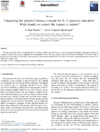Abstract
The term “physical literacy” is gaining traction in many countries and institutions as a goal for physical education. This paper explores the concept of physical literacy and highlights the foundational work in this area, particularly that of Margaret Whitehead. The relationship of physical literacy to physical education is also discussed with potential ramifications for teachers and learners who adopt physical literacy as the goal of the subject area.
Over the past few years, there has been a growing interest, worldwide, in the concept of physical literacy. In a global environmental scan of physical literacy, Spengler1 highlighted 10 countries that all recognize physical literacy either explicitly or implicitly in their policies and programs. Seven of these countries ranked within the top 25 for obesity prevalence. In countries such as UK and Canada, a number of new major national programs have been developed to focus on this relatively new concept. Canada may have the most comprehensive adoption of physical literacy and has incorporated the concept into schools, national federations, and its long-term athlete development programs. In fact, physical literacy has been a key component of discussions about how sport, recreation, health, and physical education (PE) can help Canada deal with its growing problems of increased levels of physical inactivity and obesity.2
The notion of physical literacy is not completely new to our society. It has been referred to by a number of authors over the years, but the concept was not systematically developed until early this century.3, 4, 5, 6 Since that time, a number of different interpretations of the concept of physical literacy have been put forth for consideration. The purpose of this paper is to “unpack” the concept of physical literacy, its role in PE, and the potential ramifications for K-12 teachers and learners.



Responses